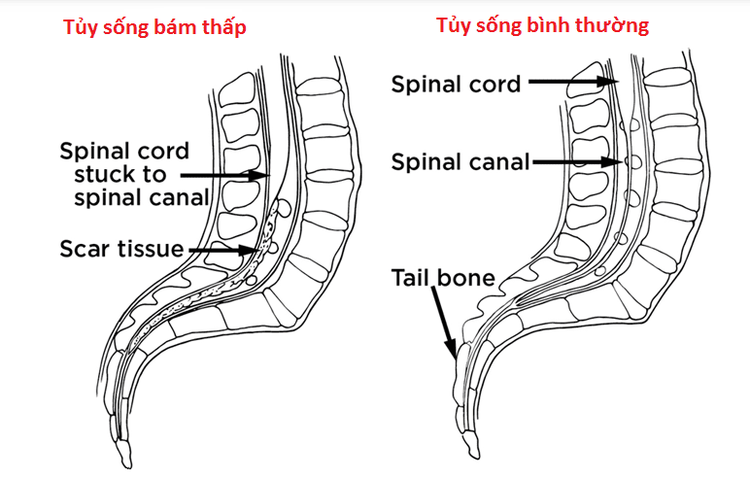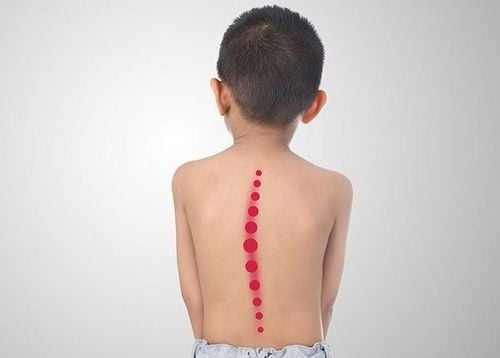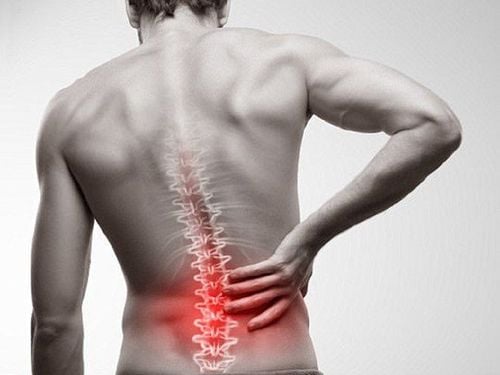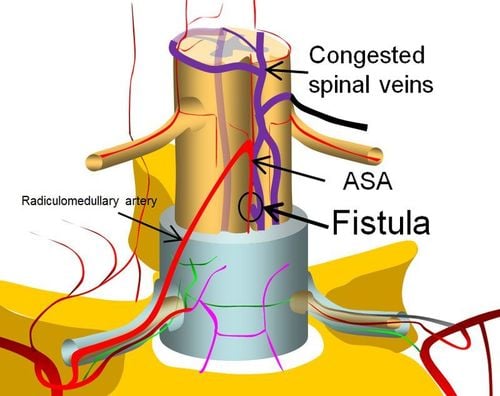This is an automatically translated article.
Among the diseases related to the spine, low back syndrome is quite common. This disease represents a neurological disorder caused by the spinal cord becoming fused with the surrounding skin, limiting the movement of the spinal cord in the patient's spine.
1. Learn about low spinal cord syndrome
Low spinal cord syndrome is a neurological disorder in the human body, which occurs when the spinal cord becomes attached to the surrounding skin, restricting the movement of the spinal cord within the spine.
Anatomically, humans are born with a spinal cord that is located at the end at the level of the intervertebral discs of the first and second lumbar vertebrae. However, for people with a herniated hernia, the spinal cord cannot separate from the skin of the back during growth, and prevents it from growing upwards as it should. Therefore, the spinal cord will be attached low or tight. As the baby continues to grow, the spinal cord will stretch and cause damage to the spinal cord, and directly affect the blood supply to the spinal cord.
In patients with low spinal cord syndrome, it is closely related to spina bifida and abnormal adhesions will cause the spinal cord to stretch. According to statistics, every year about 20-50% of children with spina bifida need surgery to release the spinal cord immediately after birth.

Hội chứng tủy sống bám thấp là tình trạng rối loạn thần kinh ở cơ thể người
2. Causes of low spinal cord syndrome
Experts say that, in addition to the main cause being due to the spinal cord being attached to the surrounding skin, low spinal cord syndrome can also be caused by:
Patients with sinus dermal fistula (rare) ; Have a bisecting spinal cord; Patients with lipoma (benign fat proliferation); Have a history of spinal cord injury; Have a history of spinal surgery; Tumors in the body; Nerve fiber thickening near the coccyx (terminal thickening).
3. Warning signs of low spinal cord syndrome
When suffering from low spinal cord syndrome, patients, especially children, will have the following warning signs:
Pinch low waist hair; Low back injury; Fatty tumor or depression behind the low back; Low waist skin discoloration; Numbness or tingling of the legs; Foot deformity; Spinal pain; Changes in leg muscle strength; Back pain, which gets worse with activity and decreases with rest; Scoliosis ; Bowel and bladder problems; Leg pain, especially in the back of the leg; Change in gait; Progressive or repetitive muscle contractions. In rare cases, the patient has no specific symptoms and is not diagnosed until adulthood and spinal cord tension can increase, leading to many sensory and motor problems in the patient. , as well as loss of bladder and bowel control.

Đau, vẹo cột sống có thể là dấu hiệu cảnh báo hội chứng tủy sống bám thấp
4. How is low spinal cord syndrome diagnosed?
In case of suspected low spinal cord syndrome, the patient needs to perform a number of tests to make an accurate diagnosis and have a timely treatment plan. Required tests include:
Magnetic Resonance Imaging (MRI): Helps doctors to make accurate imaging diagnoses thanks to three-dimensional images of body structures, by using strong magnetic fields and computer technology. Magnetic resonance imaging (MRI) can show the spinal cord, nerves, surrounding areas and more broadly, show degenerative images as well as tumors on the patient's body.
Myleogram : X-ray technique of the spinal canal can help see images of tumors pressing on the spinal cord or nerves due to low spinal cord attachment.
Computed tomography (CT or CAT scan): This special imaging technique uses X-rays. The doctor can use a myelogram to show the contrast dye flowing around the nerves. and spinal cord of the patient.
Ultrasound: With this technique, the doctor will use a water-soluble gel placed on the skin where the probe probe is to be examined, to help the transducer make good contact with the patient's skin surface and show an image. of the spinal cord moves easily within the dural sac.
5. When is surgery needed for low-attachment spinal syndrome?
Surgical method to release the spinal cord for patients with low spinal cord syndrome is performed when the patient has worsening clinical signs.
During surgery, the surgeon will open the old incision where the spinal canal is open and down to the dura covering the herniated - medullary membrane of the patient. In many cases, a small portion of the vertebral column will be removed for better exposure or to decompress the spinal cord. Next, the dura mater will be opened, the spinal cord and the herniated mass - the medulla oblongata will be gently separated from the surrounding dural adhesions. When the medullary hernia mass is freed from all its adhesions, the dura mater and incision are closed.
After surgery, the patient can return to normal activities for a few weeks, the recovery time is fast or slow depending on the extent and length of the illness before the surgery.
In some cases, patients may experience complications after surgery with low spinal cord syndrome such as bleeding, infection, spinal cord injury or herniated mass - medullary membrane, decreased muscle strength or bowel bladder .
Please dial HOTLINE for more information or register for an appointment HERE. Download MyVinmec app to make appointments faster and to manage your bookings easily.
Reference source: Manual of the Ministry of Health












